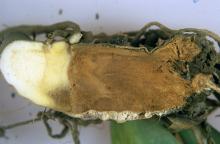Cause Botrytis convoluta, a fungus that overwinters as large, convoluted, black sclerotia in affected plant parts and in soil. Diseased rhizomes are the principal way by which the disease is disseminated. Frequently, rhizomes appear healthy but carry the fungus as latent infections.
Symptoms Plants fail to grow in spring. Rhizomes rot, and many black, convoluted sclerotia are on them.
Cultural control
- Select rhizomes only from pathogen-free plantings.
- Discard diseased rhizomes.
- Prune out diseased parts of rhizomes and plant only if pathogen-free rhizomes are not available.
Chemical control Soak new rhizomes (up to 4 to 6 inches of the leaves) in fungicide before planting. Best when used with cultural controls. Cleary's 3336, Chipco 26019, or Mertect 340 F are legal to use and may provide some benefit.
- Astun at 10 to 17 fl oz/100 gal water. Group 7 fungicide. 12-hr reentry.
- Decree 50 WDG at 0.75 to 1.5 lb/100 gal water. Do not apply more than twice sequentially. Group 17 fungicide. 12-hr reentry.
- OHP 6672 4.5 F at 16 to 20 fl oz/100 gal water. Group 1 fungicide. 12-hr reentry.
- Pageant at 12 to 18 oz/100 gal water. Do not use with organosilicone-based adjuvants. Group 7 + 11 fungicide. 12-hr reentry.
Reference Maas, J.L. 1968. Factors affecting development of Iris rhizome rot caused by Botrytis convoluta. Oregon State University Ph.D. thesis.


